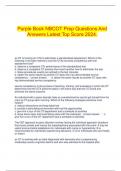College aantekeningen
Summary International Business Strategy (IBS) - A. Sels and A. Slangen (MBA - KUL)
- Vak
- Instelling
Lecture notes (16 lectures) of the course International Business Strategy (IBS), taught by A. Sels and A. Slangen in sept-dec 2020 at the KU Leuven Campus Brussel.
[Meer zien]














